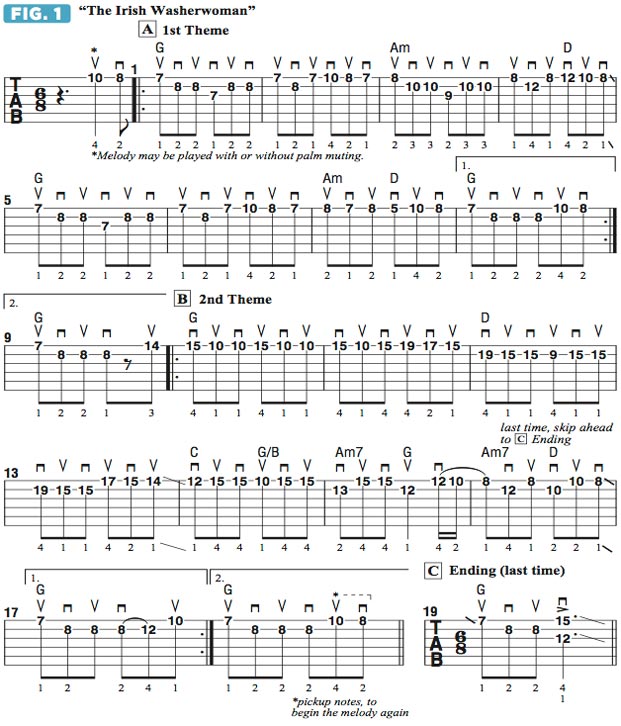Flatpicking “The Irish Washerwoman” at an Accelerating Tempo
And now, something less serious than Beethoven.

And now, something less serious than Beethoven.
Here’s a fun, “Betcha Can’t Play This” solo guitar arrangement of a popular, traditional Irish folk melody and fiddle tune, “The Irish Washerwoman,” which I’ve adapted, in the timely spirit of St. Patrick’s Day, to play pick-style, like a bluegrass mandolinist in a flatpicking contest (see FIGURE 1).
The rhythm is that of a lively jig, with a nearly unbroken stream of eighth-note triplets, played in 6/8 meter—three notes per beat, two beats per bar. The tempo should be, at a minimum, a moderate 130 beats per minute, although the tune is typically performed more quickly, in the 160–180 range, with 200 being in virtuoso/hillbilly-freak territory.
Despite its lighthearted, humble “peasant” character, this sprightly melody is quite challenging to play smoothly and cleanly on guitar at faster tempos. First, there are many reiterated notes, which mostly rules out legato phrasing and makes alternate picking the primary technique. I do, however, employ a double pull-off in bar 15, as a decorative, Celtic-style melodic ornament, and a single hammer-on in bar 17.
The second thing that makes the melody challenging to play is the frequent use of a perfect-fourth interval, which requires you to either make a wide and potentially uncomfortable five-fret stretch or quickly cross to a lower or higher string, which can be demanding on the pick hand when attempting to alternate picking quickly.
After considerable experimentation with and deliberation over various fingering possibilities and their associated picking requirements, I’ve settled upon what is presented here, which I believe offers the most practical way to perform the melody with consistently clear articulation while minimizing fret-hand discomfort (the stretches fortunately occur high up the neck, making for shorter finger spans) and avoiding the dreaded “inside-the-strings” picking, which is arduous for the pick hand and takes away from the joy of flatpicking, in all but one instance—midway through bar 15, although the double pull-off that immediately follows gives the pick hand a brief, welcome rest. Notice that we begin the piece on an upstroke and that there are a few quick position shifts employed throughout, especially during the “B” section.
To me, the most fun and entertaining way to play “The Irish Washerwoman” is to repeat the entire melody several times, starting at a relaxed, laid-back tempo—the dramatic “slow clap,” if you will—and ramping it up a few notches every time you restart the entire “AABB” form (after taking all the indicated repeats). This makes it an engaging game for both performer and audience, especially if folks clap along.
Try playing the melody together in unison with another musician, and see who “crashes” first, or just have another guitarist strum the chords in an improvised rhythm and keep up with your tempo changes. As you shift into “high gear,” you may find it helpful to tap your foot only on beat one of each bar (feeling the pulse “in one”), as opposed to tapping on both beats one and two, which can become frantic at faster tempos and possibly cause a leg cramp.
String Theory April 2016 FIGURE 1

Get The Pick Newsletter
All the latest guitar news, interviews, lessons, reviews, deals and more, direct to your inbox!
Over the past 30 years, Jimmy Brown has built a reputation as one of the world's finest music educators, through his work as a transcriber and Senior Music Editor for Guitar World magazine and Lessons Editor for its sister publication, Guitar Player. In addition to these roles, Jimmy is also a busy working musician, performing regularly in the greater New York City area. Jimmy earned a Bachelor of Music degree in Jazz Studies and Performance and Music Management from William Paterson University in 1989. He is also an experienced private guitar teacher and an accomplished writer.
“There are so many sounds to be discovered when you get away from using a pick”: Jared James Nichols shows you how to add “snap, crackle and pop” to your playing with banjo rolls and string snaps
Don't let chord inversions bamboozle you. It's simply the case of shuffling the notes around








![Joe Bonamassa [left] wears a deep blue suit and polka-dotted shirt and plays his green refin Strat; the late Irish blues legend Rory Gallagher [right] screams and inflicts some punishment on his heavily worn number one Stratocaster.](https://cdn.mos.cms.futurecdn.net/cw28h7UBcTVfTLs7p7eiLe.jpg)


